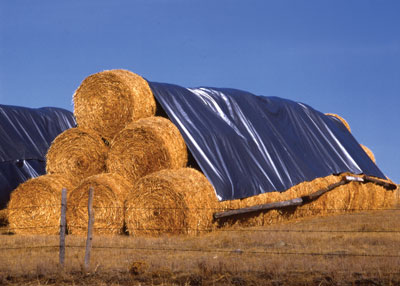
Features
Agronomy
Tillage
Baling straw can be done sustainably
Whether it is smoked or exported off the farm, there is a value to straw. And with the increased interest in cellulose ethanol, biofuels and bio-industrial applications, the question about the sustainability of straw removal often comes up. “If straw is removed from the field, there are implications on the removal of carbon and the impact on soil organic matter,” says Guy Lafond, a research scientist at Agriculture and Agri-Food Canada at Indian Head, Saskatchewan.
March 18, 2010 By Bruce Barker
Whether it is smoked or exported off the farm, there is a value to straw. And with the increased interest in cellulose ethanol, biofuels and bio-industrial applications, the question about the sustainability of straw removal often comes up. “If straw is removed from the field, there are implications on the removal of carbon and the impact on soil organic matter,” says Guy Lafond, a research scientist at Agriculture and Agri-Food Canada at Indian Head, Saskatchewan.
Lafond says that crop residues should not be viewed simply as a waste product because of its critical role in sustaining soil organic matter and the importance of soil organic matter in the global carbon cycle. Soil organic matter is important for its impact on soil physical, chemical and biological properties. He explains that on the Canadian Prairies, the carbon input into the soil is directly related to the amount of crop residues produced and returned to the soil.
While several Prairie studies have shown no effect of straw removal in studies of up to 30 years, Lafond wanted to go further, and see what impact might be found after 50 years of straw removal. He looked at the results from the Indian Head Long-Term Crop Rotations, which were established in 1958, with the last 18 years under no-till. His analysis looked at the impact of straw removal on spring wheat grain yields, grain protein content, soil organic carbon and nitrogen.
Lafond’s review updated the results of a previous study that looked at the first 30 years from 1958 to 1987. The rotation investigated was a fallow-spring wheat-spring wheat (F-W-W) rotation. The first treatment was not fertilized, but had straw retained. The second was fertilized with straw retained, while the last was fertilized but the straw baled during the wheat years. The plots were managed using relevant agronomic practices, and nitrogen and phosphorus fertilizer was applied based on soil residual levels from samples taken the previous fall.
Lafond’s results were similar to the first 30 years; grain yield, protein content and carbon were not significantly affected by straw removal when removed two of three years.

|
Lafond notes that there was not a significant change in total soil organic carbon, and so there would be no effect on N balance, either. To back that up, he points out that the N balance, as measured by the N fertilizer added versus the N removed was equal. “The N budget was in equilibrium,” explains Lafond. He says that P budget was also similar; with fertilizer additions more or less replacing what was removed.

|
|
| Long-term trials did not see a decrease in soil quality, but there are qualifiers. (Photo by Bruce Barker)
|
Less straw removed by baling than previously thought
While the results may seem to be counter-intuitive, the reason why straw removal did not have a long-term impact may have something to do with the amount of straw actually removed from the field. Previous estimates of crop residue removal through baling had suggested up to 66 percent was removed as straw, with the rest remaining on the field as stubble and chaff.
Additionally, it is thought that crop roots are contributing more carbon to the soil and soil organic matter than above ground residues. For example, research in the US found that carbon input into the soil from corn roots and rhizodepositions was 1.7 to 1.8 times that of above-ground residues.
Lafond compared three different baling operations to better understand how much straw is removed. The first was a swath, combine and bale operation. The second, a straight cut and bale operation, while the last utilized a stripper header for straight combining, followed by a swathing of the remaining stubble and baling.
During the four years of trials, the swath/bale treatment removed 38 percent of the above-ground residue, the straight-cut/bale removed 30 percent, and the stripper header treatment removed 24 percent. However, the stubble after the stripper header stubble was trampled during combining, so the amount of residue removed may not accurately reflect the potential straw removal given the width of the combine wheels relative to the width of the header used.
Lafond cautions that the percentage of crop residue removed varies with crop yield and precipitation. In addition, he says that the straw height they left was five inches, and that as stubble is cut higher, the proportion of straw removed would be lower, and rotary combines would leave even less straw for removal. “Baling only removes a small proportion of the above-ground residues, so the long term effects are limited. Removal of the straw two-thirds of the time in this type of rotation and soil zone have not shown to lead to lower soil quality,” explains Lafond.
Lafond says that previously, the price for selling straw off the land was often viewed as the replacement cost of the nutrients exported with the straw. He suggests that perhaps the full nutrient value does not need to be budgeted in the cost, since there does not seem to be a negative impact on soil quality. But he adds one qualifier. “Research in Europe suggests you can go 50 years before you see a change in soil quality when removing straw. So maybe we will see a difference in another 50 years.”